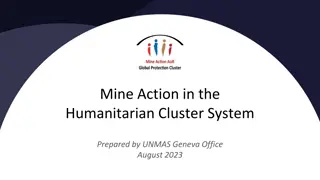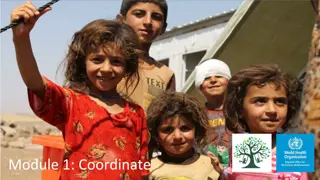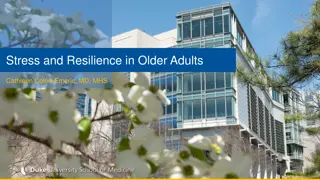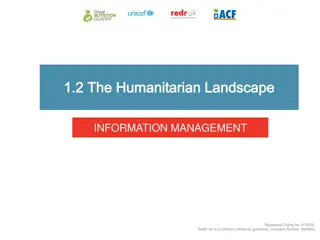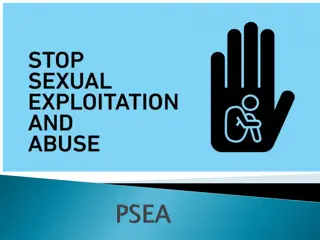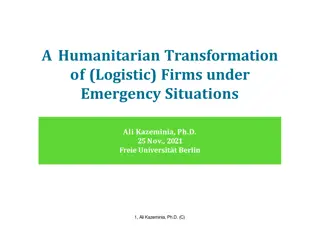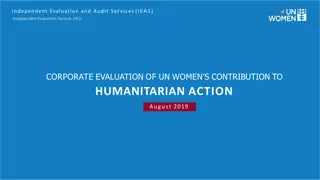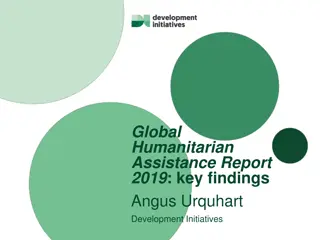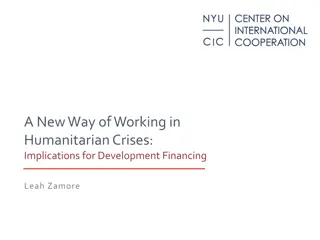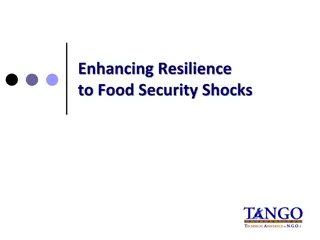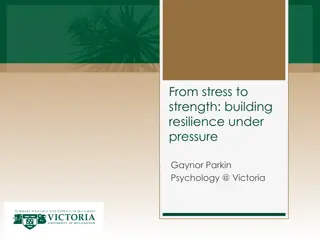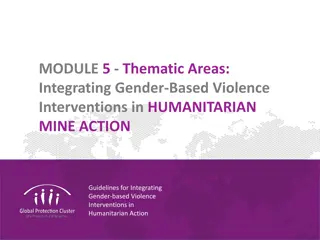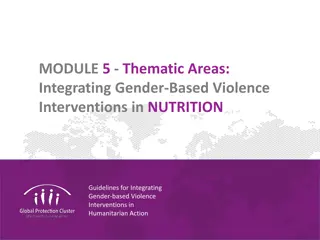Insights on Community Resilience Building in Humanitarian Response
This study explores the perceptions and recommendations of local stakeholders, including first responders and survivors of crises, on strengthening humanitarian response to foster long-term community resilience. Key findings include the importance of community involvement, coordination with governments, addressing root causes of vulnerability, and providing psychosocial support and livelihood opportunities. The study emphasizes the need for independence, support, and effective communication to enhance resilience in emergency contexts.
Download Presentation

Please find below an Image/Link to download the presentation.
The content on the website is provided AS IS for your information and personal use only. It may not be sold, licensed, or shared on other websites without obtaining consent from the author.If you encounter any issues during the download, it is possible that the publisher has removed the file from their server.
You are allowed to download the files provided on this website for personal or commercial use, subject to the condition that they are used lawfully. All files are the property of their respective owners.
The content on the website is provided AS IS for your information and personal use only. It may not be sold, licensed, or shared on other websites without obtaining consent from the author.
E N D
Presentation Transcript
START DEPP: Linking Preparedness START DEPP: Linking Preparedness Response and Resilience in Emergency Response and Resilience in Emergency Contexts Contexts Community Resilience Building in Humanitarian Response; Insights Community Resilience Building in Humanitarian Response; Insights from Crises Survivors and First Responders from Crises Survivors and First Responders May 2017 May 2017
The LPRR Studys Aim To capture the recommendations and perceptions made by local stakeholders (first responders and crises survivors) for how humanitarian response can be strengthened to enable (and not undermine) long term community resilience building. What is new? What is our contribution to the debate? 1. Recent calls to re-open the debate and apply research to understand how resilience can offer the answer this ongoing debate has inspired this LPRR project and study. 2. The LPRR project identified two gaps in existing research: 3. A lack of knowledge that focuses on asking crises survivors and first responders their recommendations 4. A lack of systematic implementation and evaluation of practical recommendations
Perception of Resilience The factors that underpinned resilience varied depending on the context and individual (for example the need for flood walls, secure income, land rights, early warning systems etc.) However, in 7 of the case studies (with the only exception being the DRC where there was a lack of data to verify) the crises survivors felt that resilience meant both independence and support when needed. Resilience means having the skills and capacity to look after yourself whilst knowing how and where to ask for support when needed. (LPRR Local Stakeholders) It is important to note that respondents felt independence to be free from international support; not their own government. Good governance and a strong local and national government capacity are two aspects that respondents felt are required to become independent.
6 No Regrets 1. Allow and enable the community to co-run the response 2. Coordinate Interventions and work with the government 3. Support community cohesion and establish effective two way communication between crises survivors and implementing organisations 4. Address underlying causes of vulnerability: protect and prepare 5. Psycho social support and 6. Livelihoods, income generation, cash and savings
1. Allow and enable the community to co-run the response Humanitarian interventions should be run by those living at risk. A lack of participation risks fragmenting social cohesion, increasing stress and anxiety and inappropriate or untimely aid. Crises survivors have expressed that they would like to be involved from the offset and empowered to run the intervention themselves, with the support of the international non-government organisations and local non-government organisations. This would increase efficiency, ensure appropriate support and allow the community to take charge of their own future.
2. Coordinate interventions and work with the government Interventions should be coordinated better. A number of crisis survivors called for just one organisation to work in the community, avoiding the confusion, anxiety and duplication that multiple actors can create. All interventions should be designed to coordinate and work with all levels of the government. To build long term resilience, humanitarian interventions should both encourage governments to take responsibility and support governments to build their capacity to do so.
3. Support community cohesion and establish effective two-way communication between crises survivors and implementing organisations Social cohesion and community togetherness is an essential attribute required for resilience. Poor communication is a cause of negative impact on community cohesion. Effective, two-way communication between the community and humanitarian organisations is an essential aspect of a humanitarian response.
4. Address underlying causes of vulnerability: protect, prepare, advocate Tackle root causes of vulnerability from the offset. A lack of independence or empowerment and societal inequalities produce vulnerability and limit resilience building. Transformational resilience requires tackling these root causes and the power structures that enforce them. The most effective way to approach this is by advocating for protection and human rights directly after a crisis.
5. Psycho social support Wellbeing and mental health are essential components of individual, household and community resilience. The emotional, spiritual and mental impact of crises significantly limit the ability for communities to bounce back better after a crisis.
6. Livelihoods and savings Lastly, crisis survivors stressed the importance of capacity building on livelihoods and savings. A focus on sustainable livelihoods is often missed in humanitarian response. Communities cannot bounce back better unless there can independently earn enough to save a surplus of money and resources as a safety net in the event of a future crisis.


